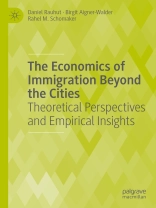This book explores how migrants and refugees can revitalise peripheral regions and communities economically. The extent to which migrants stimulate the economic activities of these regions through labour market participation, entrepreneurship, innovation and consumption is examined theoretically and empirically for the EU as a whole, as well as through empirical case studies that highlight the impact of migration at macro, company, and individual levels. A particular focus is given to the economic consequences of Third Country Nationals to places beyond the cities, i.e. the peripheral and remote regions of Europe.
This book aims to provide insight into the role of migrations in low productive and labour-intensive regions. The authors provide innovative policy recommendations to stimulate the positive economic consequences of immigration to places beyond the cities. It will be of interest to students, researchers, and policymakers working within labour economics and migration and integration policies.
Daftar Isi
1. Introduction.- 2. Economic theories on the impact of immigration.- 3. The spatial aspect of immigrant settlement.- 4. Different scale, different impacts.- 5. Macro level consequences.- 6. Company level consequences.- 7. Consequences for individuals.- 8. One-size-fits-all? Policy implications for different levels.- 9. Immigration, allocation and regional development.- 10. Concluding remarks.
Tentang Penulis
Daniel Rauhut is an Associate Professor in Regional Planning, is an affiliated researcher at the University of Lisbon, and has a Ph D in Economic History.
Birgit Aigner-Walder is Professor of economics at the Carinthia University of Applied Sciences.
Rahel M. Schomaker is Professor of economics and public administration at the Carinthia University of Applied Sciences.












